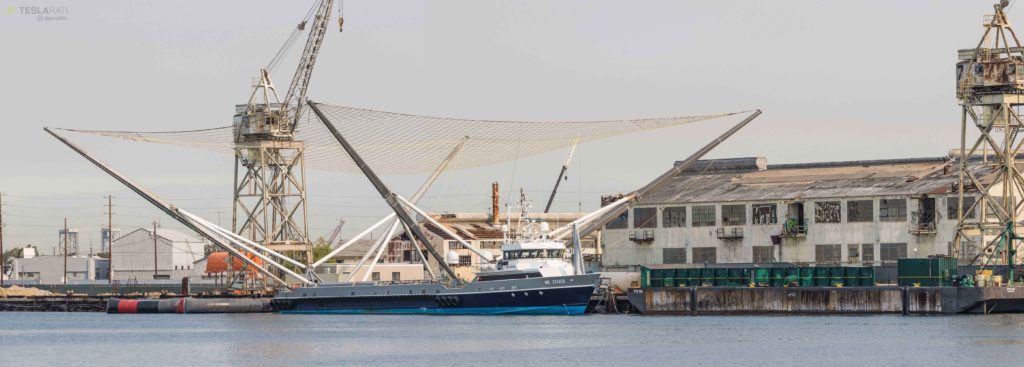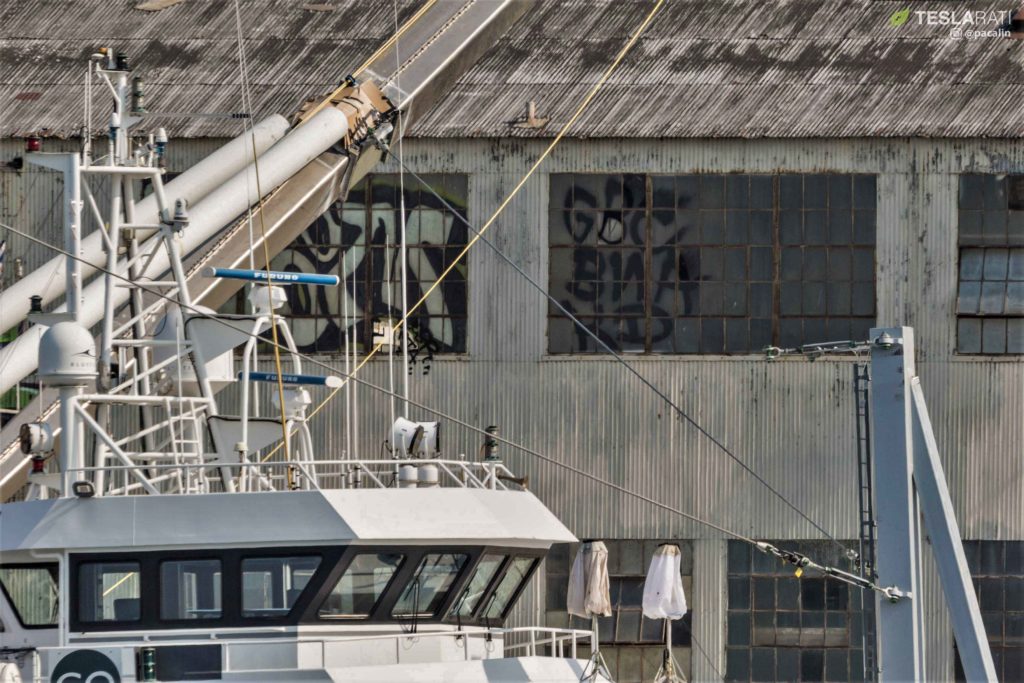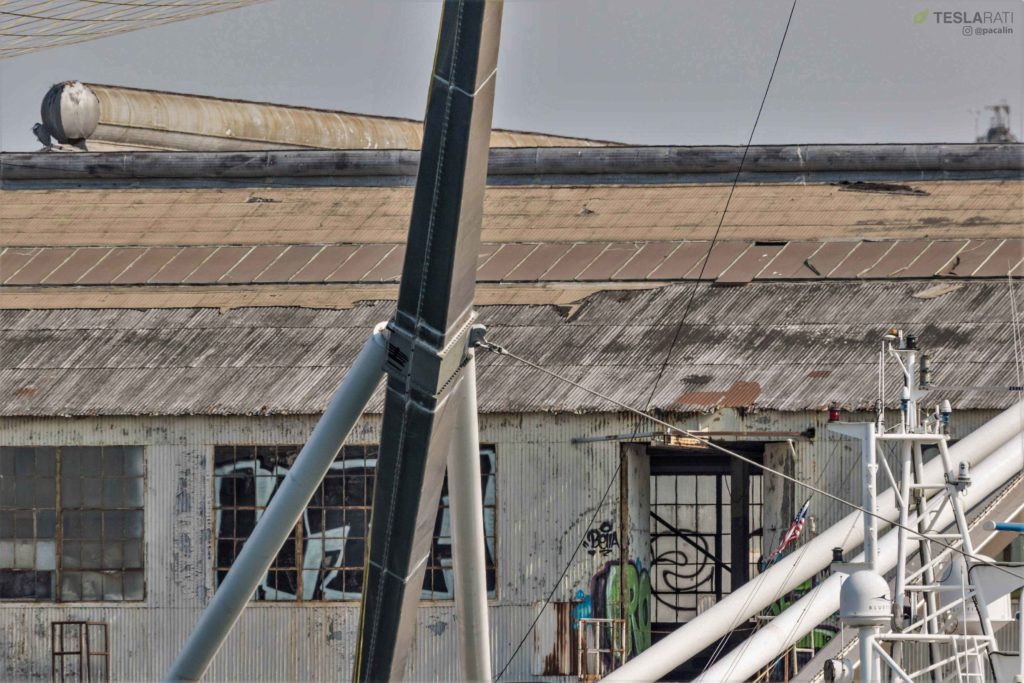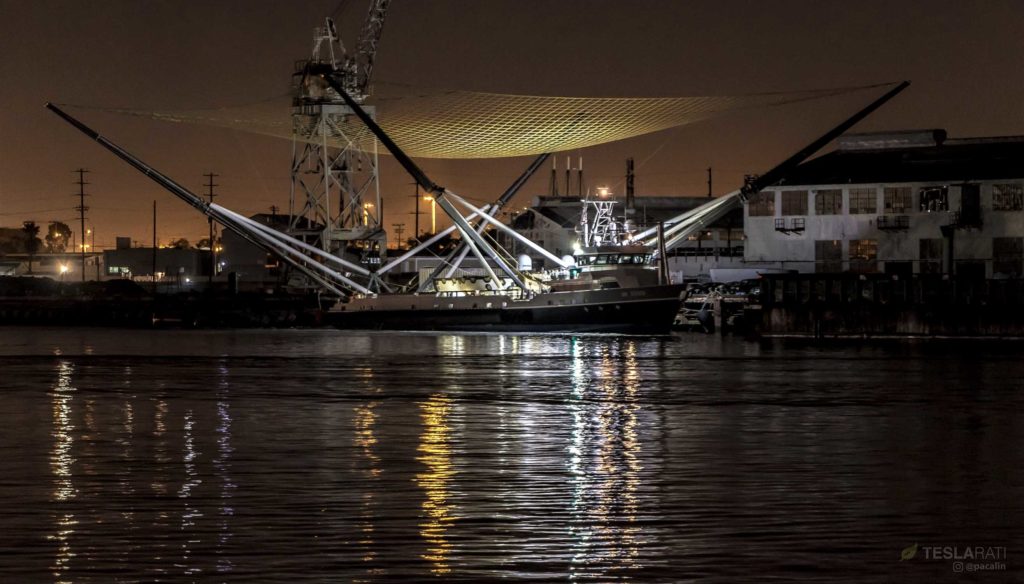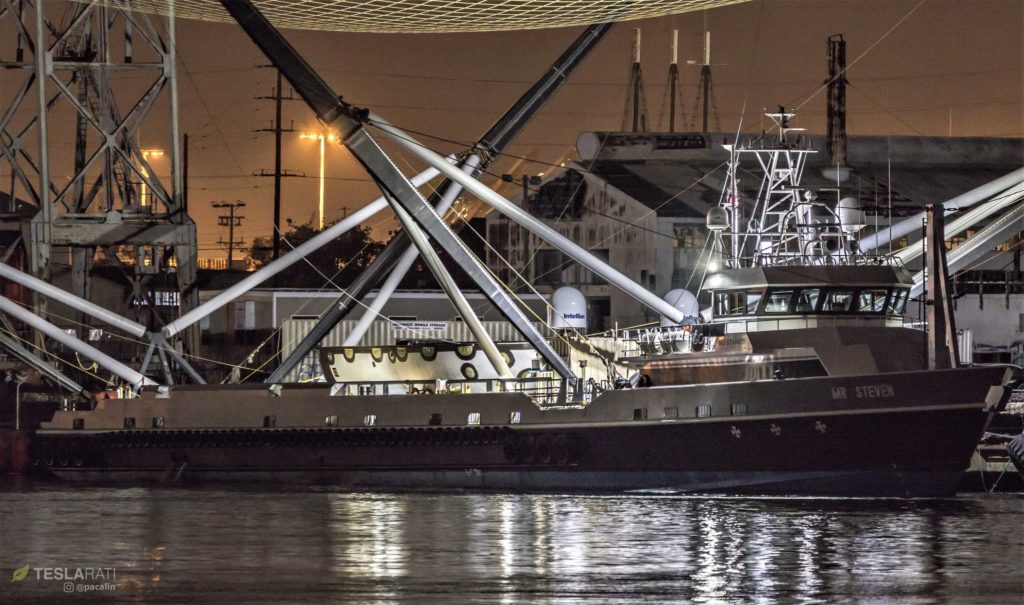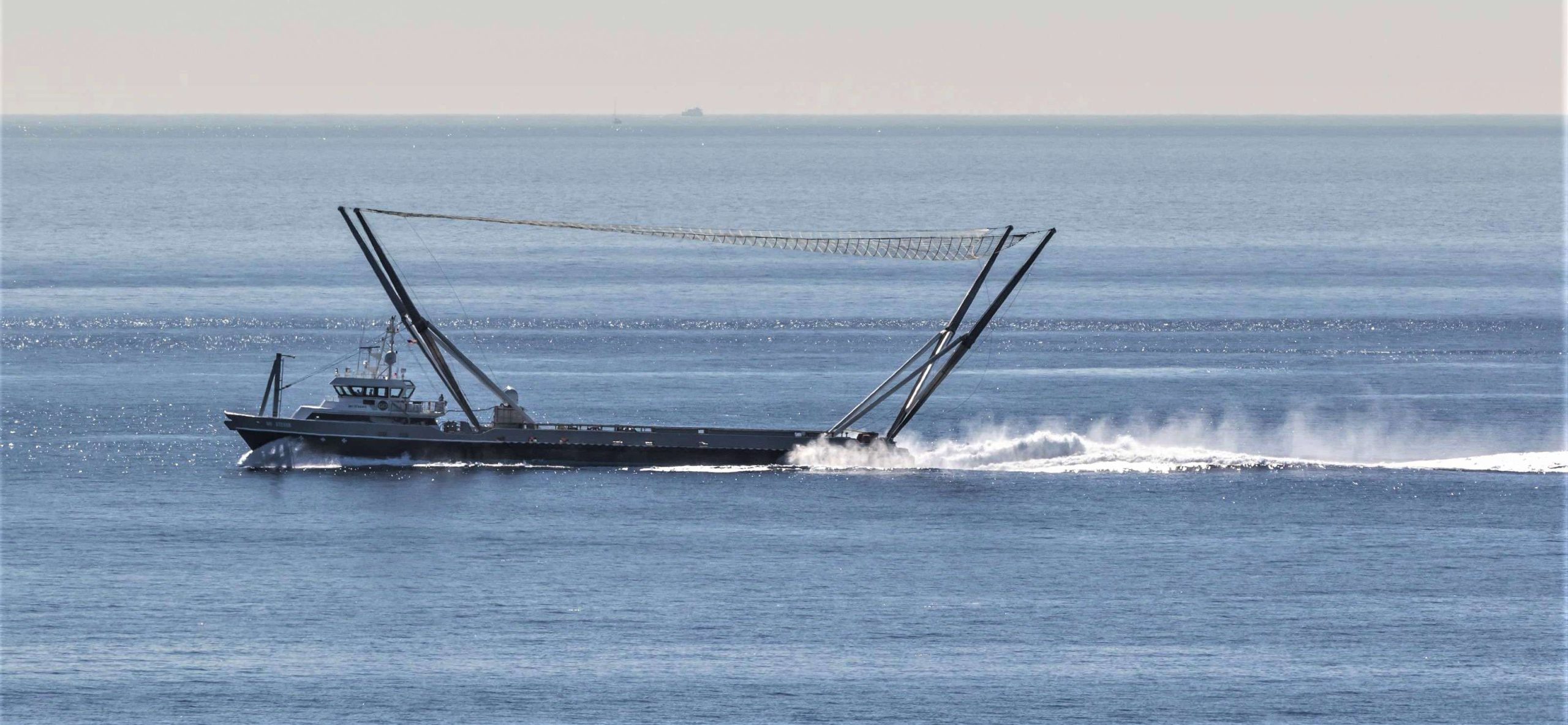
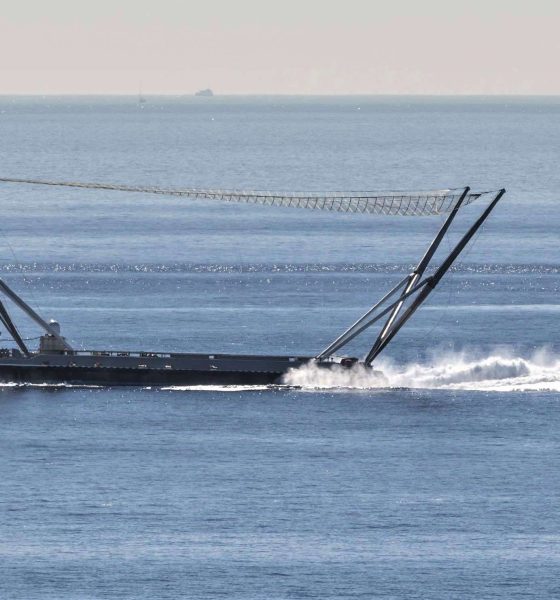
News
SpaceX Falcon fairing recovery vessel Mr. Steven tests out new limbs at sea
After a week or so spent installing a new and moderately ambiguous arm on the nose of Falcon fairing recovery vessel Mr. Steven, SpaceX’s recovery crew performed a number of high-speed sea trials a few miles off the shore of Port of Los Angeles, testing out something.
Just a few days later, Mr. Steven returned to the general region surrounding Catalina Island, where – by all appearances – SpaceX technicians performed the most recent Falcon fairing drop/catch test. Using a helicopter to pick up the test-dedicated fairing half from a barge, eventually dropping it from around 10,000 feet, this offers Mr. Steven a much higher volume of controlled attempts at both catching a parasailing fairing and optimizing the technology and recovery methods involved.
Mr Steven arriving back at port after some sea trials (with some new hardware near his nose). Such an elegant ship. The drop-test fairing is back in view on the dock as well. Soooooon……#spacex #mrsteven @Teslarati pic.twitter.com/qsmEy2Kk2a
— Pauline Acalin (@w00ki33) November 12, 2018
Over the last few weeks, Teslarati photographer Pauline Acalin has reliably kept up with Mr. Steven, documenting a variety of recent physical changes to the vessel. Most notably, these changes include the installation of a visible and quite curious stanchion (or arm) at the ship’s aft tip (nose). Simply due to a lack of any real information about the experiences of operating Mr. Steven and attempting to catch Falcon fairings, it’s all but impossible to know for sure what this new limb accomplishes or why it was needed in the first place.
Armed to the teeth
More clear are general visual observations and the reasonable extrapolations that can be derived from them. At the simplest level, this new limb is clearly well-reinforced, at least no less so than any of Mr. Steven’s other arms and attachment points. Aside from a basic off-the-shelf ladder for crew and technician access, the stanchion plays host to four basic swinging arms with what looks like one or maybe one and a half degrees of freedom, allowing them to pivot roughly 180 degrees along the plane of the angle they were installed at.
- An overview of Mr. Steven on November 10th, shortly after his new arm’s cables were attached. (Pauline Acalin)
- A good closeup of Mr. Steven’s new limb and its associated cables, cable linkages, and arm attachments. (Pauline Acalin, 11/10/18)
- A different view of the arm-cable attachment fixtures. (Pauline Acalin)
Secured to the ends of those four simple arms are four heavy-duty coiled metal cables, themselves attached to the center of Mr. Steven’s two foremost arms (two cables per arm). Curiously, the ship’s Nov. 12 sea trials were conducted with just the bottom two cables attached to each respective arm, visible in photos of the outing. Upon returning from a Nov. 14 fairing drop-and-catch test, both upper and lower cable sets were seen attached to his aft arms. During the nearby sea trials, no clearly abnormal behavior – compared against previous trials at similar speeds and the same location – was observed, although the new metal cables were visibly taut or nearly so.
Given just how seemingly nuanced the utility of this new arm and cable combo seems to be, a few obvious conclusions and possible explanations can be drawn. Perhaps Mr. Steven experiences inconvenient arm bouncing while sailing at high speeds, particularly in high speeds, and holding his arms down serves to grease the metaphorical gears of fairing recovery. Maybe the recovery net – stretched between four large arms – is tensioned more than SpaceX fairing recovery engineers and technicians would like, partially shrinking the usable catching area by pulling each arm towards the center. Even more nuanced still, it may be the case that these new tensioning steel cables and stanchion make it easier for fairing halves to be processed after landing in Mr. Steven’s net, allowing the crew to accurately and rapidly move the fairing to an optimal section of the net.
- (Pauline Acalin)
- Note the duo of cables connected to the arm attachment jig. (Pauline Acalin)
More questions than answers
Regardless, none of these best-case, simple explanations for the new hardware satisfactorily mesh with the known facts surrounding Mr. Steven and Falcon fairing recovery in general. For any of the above scenarios to be true, one must essentially assume that SpaceX has already nailed down fairing recovery and catches or believes that the path to solving those problems is almost totally clear of obstacles. If not, it would feel more than a little like putting the cart before the horse (or the fairing before the net) to be optimizing Mr. Steven for operations that are – as of yet – out of reach.
If SpaceX were so close to closing the fairing recovery gap, one would generally expect Mr. Steven to attempt fairing recoveries after all true Falcon 9 launches while also performing controlled drop test catch attempts. However, no such attempt was made after the October 7 launch of SAOCOM-1A and – according to CEO Elon Musk – Mr. Steven will not be attempting to catch Falcon 9’s fairing(s) after the imminent launch of SSO-A, expected to occur sometime after Thanksgiving (later this week).
Will try again next month
— Elon Musk (@elonmusk) November 14, 2018
For prompt updates, on-the-ground perspectives, and unique glimpses of SpaceX’s rocket recovery fleet check out our brand new LaunchPad and LandingZone newsletters!

News
Ford cancels all-electric F-150 Lightning, announces $19.5 billion in charges
“Rather than spending billions more on large EVs that now have no path to profitability, we are allocating that money into higher returning areas, more trucks and van hybrids, extended range electric vehicles, affordable EVs, and entirely new opportunities like energy storage.”
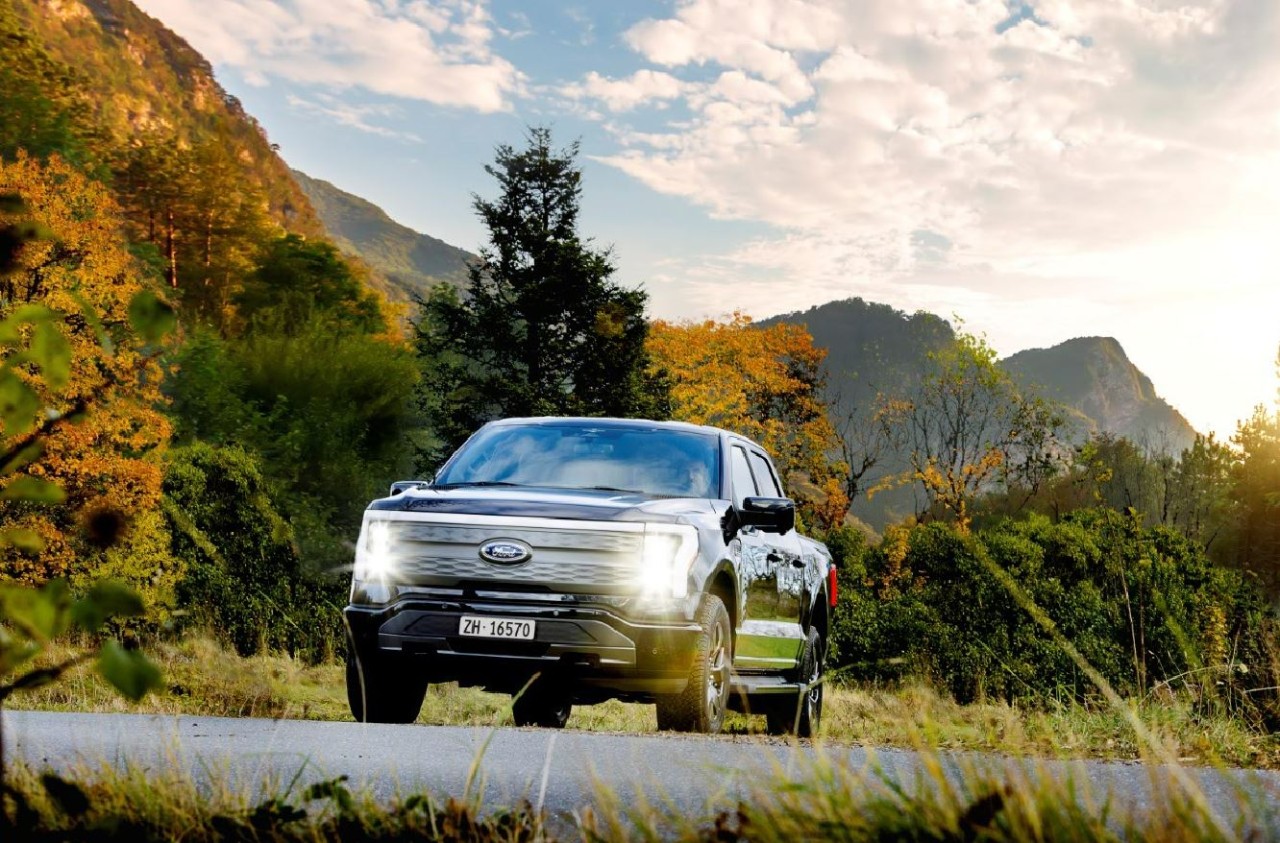
Ford is canceling the all-electric F-150 Lightning and also announced it would take a $19.5 billion charge as it aims to quickly restructure its strategy regarding electrification efforts, a massive blow for the Detroit-based company that was once one of the most gung-ho on transitioning to EVs.
The announcement comes as the writing on the wall seemed to get bolder and more identifiable. Ford was bleeding money in EVs and, although it had a lot of success with the all-electric Lightning, it is aiming to push its efforts elsewhere.
It will also restructure its entire strategy on EVs, and the Lightning is not the only vehicle getting the boot. The T3 pickup, a long-awaited vehicle that was developed in part of a skunkworks program, is also no longer in the company’s plans.
Instead of continuing on with its large EVs, it will now shift its focus to hybrids and “extended-range EVs,” which will have an onboard gasoline engine to increase traveling distance, according to the Wall Street Journal.
“Ford no longer plans to produce select larger electric vehicles where the business case has eroded due to lower-than-expected demand, high costs, and regulatory changes,” the company said in a statement.
🚨 Ford has announced it is discontinuing production of the F-150 Lightning, as it plans to report a charge of $19.5 billion in special items.
The Lightning will still be produced, but instead with a gas generator that will give it over 700 miles of range.
“Ford no longer… pic.twitter.com/ZttZ66SDHL
— TESLARATI (@Teslarati) December 15, 2025
While unfortunate, especially because the Lightning was a fantastic electric truck, Ford is ultimately a business, and a business needs to make money.
Ford has lost $13 billion on its EV business since 2023, and company executives are more than aware that they gave it plenty of time to flourish.
Andrew Frick, President of Ford, said:
“Rather than spending billions more on large EVs that now have no path to profitability, we are allocating that money into higher returning areas, more trucks and van hybrids, extended range electric vehicles, affordable EVs, and entirely new opportunities like energy storage.”
CEO Jim Farley also commented on the decision:
“Instead of plowing billions into the future knowing these large EVs will never make money, we are pivoting.”
Farley also said that the company now knows enough about the U.S. market “where we have a lot more certainty in this second inning.”
News
SpaceX shades airline for seeking contract with Amazon’s Starlink rival

SpaceX employees, including its CEO Elon Musk, shaded American Airlines on social media this past weekend due to the company’s reported talks with Amazon’s Starlink rival, Leo.
Starlink has been adopted by several airlines, including United Airlines, Qatar Airways, Hawaiian Airlines, WestJet, Air France, airBaltic, and others. It has gained notoriety as an extremely solid, dependable, and reliable option for airline travel, as traditional options frequently cause users to lose connection to the internet.
Many airlines have made the switch, while others continue to mull the options available to them. American Airlines is one of them.
A report from Bloomberg indicates the airline is thinking of going with a Starlink rival owned by Amazon, called Leo. It was previously referred to as Project Kuiper.
American CEO Robert Isom said (via Bloomberg):
“While there’s Starlink, there are other low-Earth-orbit satellite opportunities that we can look at. We’re making sure that American is going to have what our customers need.”
Isom also said American has been in touch with Amazon about installing Leo on its aircraft, but he would not reveal the status of any discussions with the company.
The report caught the attention of Michael Nicolls, the Vice President of Starlink Engineering at SpaceX, who said:
“Only fly on airlines with good connectivity… and only one source of good connectivity at the moment…”
CEO Elon Musk replied to Nicolls by stating that American Airlines risks losing “a lot of customers if their connectivity solution fails.”
American Airlines will lose a lot of customers if their connectivity solution fails
— Elon Musk (@elonmusk) December 14, 2025
There are over 8,000 Starlink satellites in orbit currently, offering internet coverage in over 150 countries and territories globally. SpaceX expands its array of satellites nearly every week with launches from California and Florida, aiming to offer internet access to everyone across the globe.
Currently, the company is focusing on expanding into new markets, such as Africa and Asia.
News
Tesla Model Y Standard stuns in new range test, besting its Premium siblings
Tesla’s newer vehicles have continued to meet or exceed their EPA estimates. This is a drastic change, as every 2018-2023 model year Tesla that Edmunds assessed did not meet its range estimates.

The Tesla Model Y Standard stunned in a new range test performed by automotive media outlet Edmunds, besting all of its Premium siblings that are more expensive and more luxurious in terms of features.
Testing showed the Model Y Standard exceeded its EPA-estimated range rating of 321 miles, as Edmunds said it is the “longest-range Model Y that we’ve ever put on our loop.” In the past, some vehicles have come up short in comparison with EPA ranges; for example, the Model Y’s previous generation vehicle had an EPA-estimated range of 330 miles, but only drove 310.
Additionally, the Launch Series Model Y, the first configuration to be built in the “Juniper” program, landed perfectly on the EPA’s range estimates at 327 miles.
It was also more efficient than Premium offerings, as it utilized just 22.8 kWh to go 100 miles. The Launch Series used 26.8 kWh to travel the same distance.
It is tested using Edmunds’ traditional EV range testing procedure, which follows a strict route of 60 percent city and 40 percent highway driving. The average speed throughout the trip is 40 MPH, and the car is required to stay within 5 MPH of all posted speed limits.
Each car is also put in its most efficient drive setting, and the climate is kept on auto at 72 degrees.
“All of this most accurately represents the real-world driving that owners do day to day,” the publication says.
With this procedure, testing is as consistent as it can get. Of course, there are other factors, like temperature and traffic density. However, one thing is important to note: Tesla’s newer vehicles have continued to meet or exceed their EPA estimates. This is a drastic change, as every 2018-2023 model year Tesla that Edmunds assessed did not meet its range estimates.
Tesla Model Y Standard vs. Tesla Model Y Premium
Tesla’s two Model Y levels both offer a great option for whichever fits your budget. However, when you sit in both cars, you will notice distinct differences between them.
The Premium definitely has a more luxurious feel, while the Standard is stripped of many of the more premium features, like Vegan Leather Interior, acoustic-lined glass, and a better sound system.
You can read our full review of the Model Y Standard below:
Tesla Model Y Standard Full Review: Is it worth the lower price?
